At the Magnani Rocca in Traversetolo, collected on the first floor of this precious art treasure chest, a rare and minute exhibition, Amedeo Modigliani. Works from the Musée de Grenoble, offers, through a few but significant loans, an opportunity to take a close look at Amedeo Modigliani’s pictorial and graphic work, on the sidelines of the centenary of his death in 1920, which has seen, admittedly, few exhibitions in Italy, due to the problematic authenticity of his catalog.
Paintings and drawings, from the Musée de Grenoble, along with other African works and fetishes that were part of Magnani’s extensive collection, allow Modigliani’s painting to speak to the six graphic works and, above all, to different currents and historical periods that are only seemingly distant: Sienese Gothic painting,art nègre and modern French painting.
At the center of the display, a detail embedded in that work summarizing his artistic and human story, which is the 1917 oil painting, la femme au col blanc, stands out.
The portrait (the first of 14 in oil) depicts Lunia, a young Polish woman from Warsaw, a guest of Léopold Zborowski, the merchant and patron, a friend of Modigliani’s, who although initially not wealthy, was a key figure in the dissemination and awareness of his style, since in 1916 he managed to secure the artist a contract and allowed him to exhibit his work even in the Dadaist exhibition organized at the Cabaret Voltaire in Zurich.
Lunia Czechowska was one of the artist’s favorite models, one of those, as she herself declares in the 1990 interview in the catalog, who never posed nude and , an extraordinary case, it took Modigliani no less than three posing sessions to create her painting. In this disruptive work there is all of Modì’s flair, even the match that stuck to the fresh paint after the canvas accidentally fell due to the violence with which Amedeo dealt with the subject matter (we know, moreover, that he painted in shirt sleeves and singing Italian songs). Lunia is in fact a portrait-symbol that not only confirms Modigliani’s predilection for female subjects (a preference that would be assumed following his meeting with the poetess Beatrice Hastings in 1914) but first and foremost brings together diffusely his most peculiar characters. From theimpenetrability of the gaze (with empty eye sockets) that is presumed to come from attention to classical statuary and a fascination with African masks (there are in fact two examples of anthropomorphic masks of the Gouro ethnic group in the exhibition, relevant in particular for their sharp profiles and prognathism) from which he will also assume a certain formal synthesis, to the use of the formulations of Sienese and Italian painting as is evident in both the color palette (blue) and the tapered lines of the woman’s long neck, as well as in the slightly reclined head, delicate pose and almond-shaped eyes that Modì saw presumably in Simone Martini’s Madonnas and perhaps, in Ambrogio Lorenzetti’sMadonna del Latte, to the choice of the three-quarter position with the crossing of the hands on the knees that is a form he inferred from Cézanne in France.
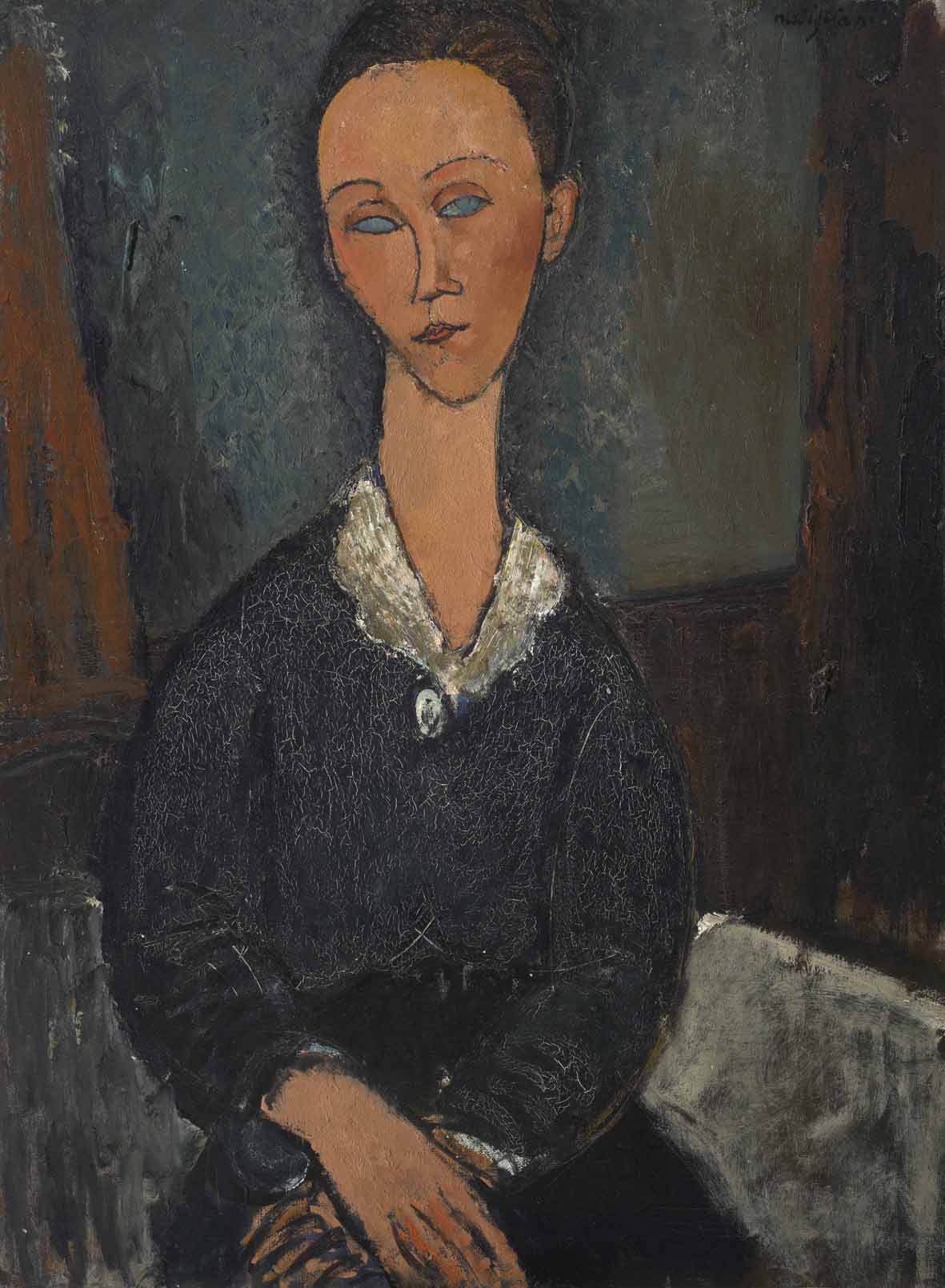 |
| Amedeo Modigliani, Femme au col blanc (1917; oil on canvas; Grenoble, Musée de Grenoble) |
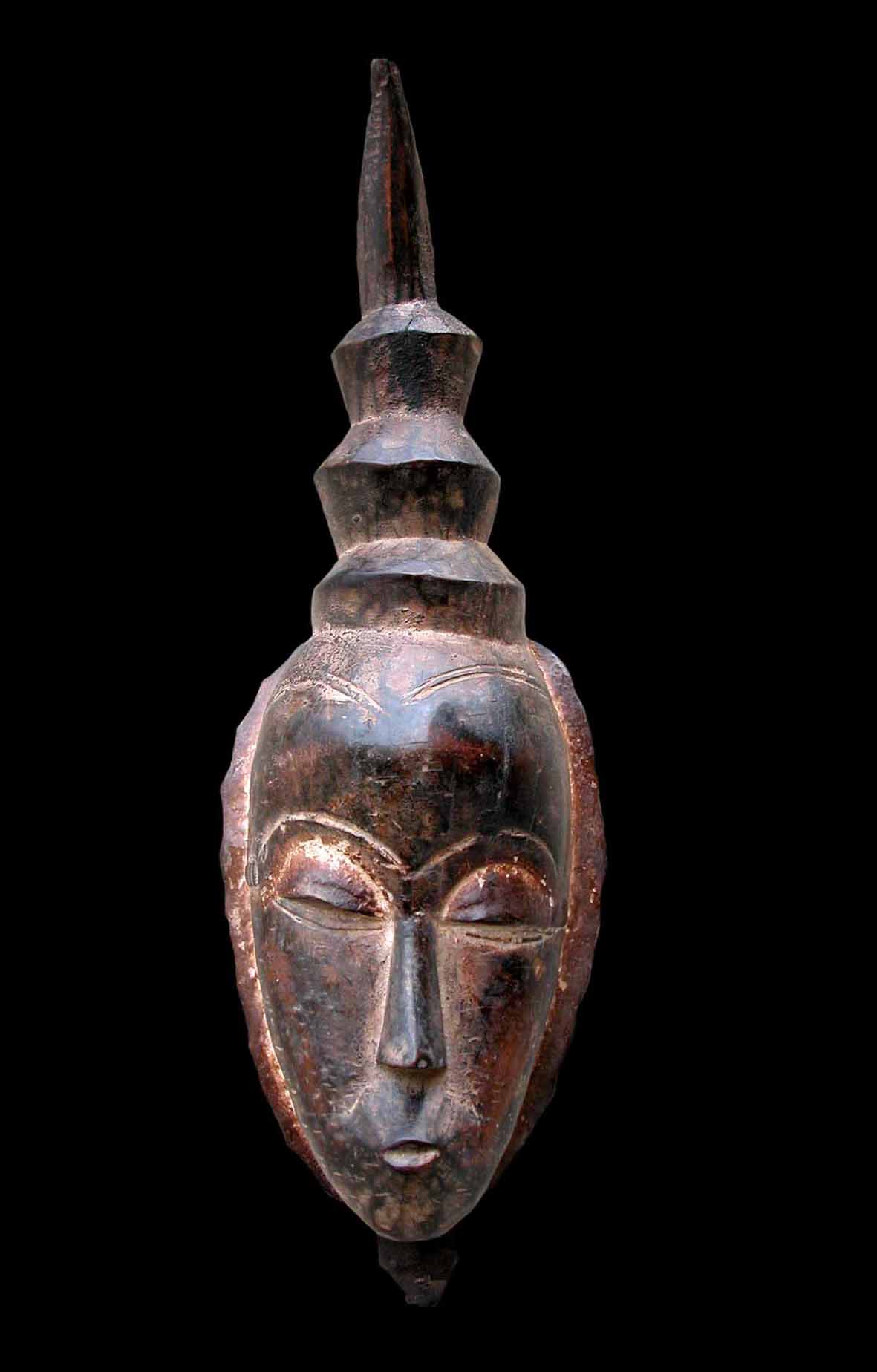 |
| African Gouro Mask, Ivory Coast (Private collection Marcello Lattari) |
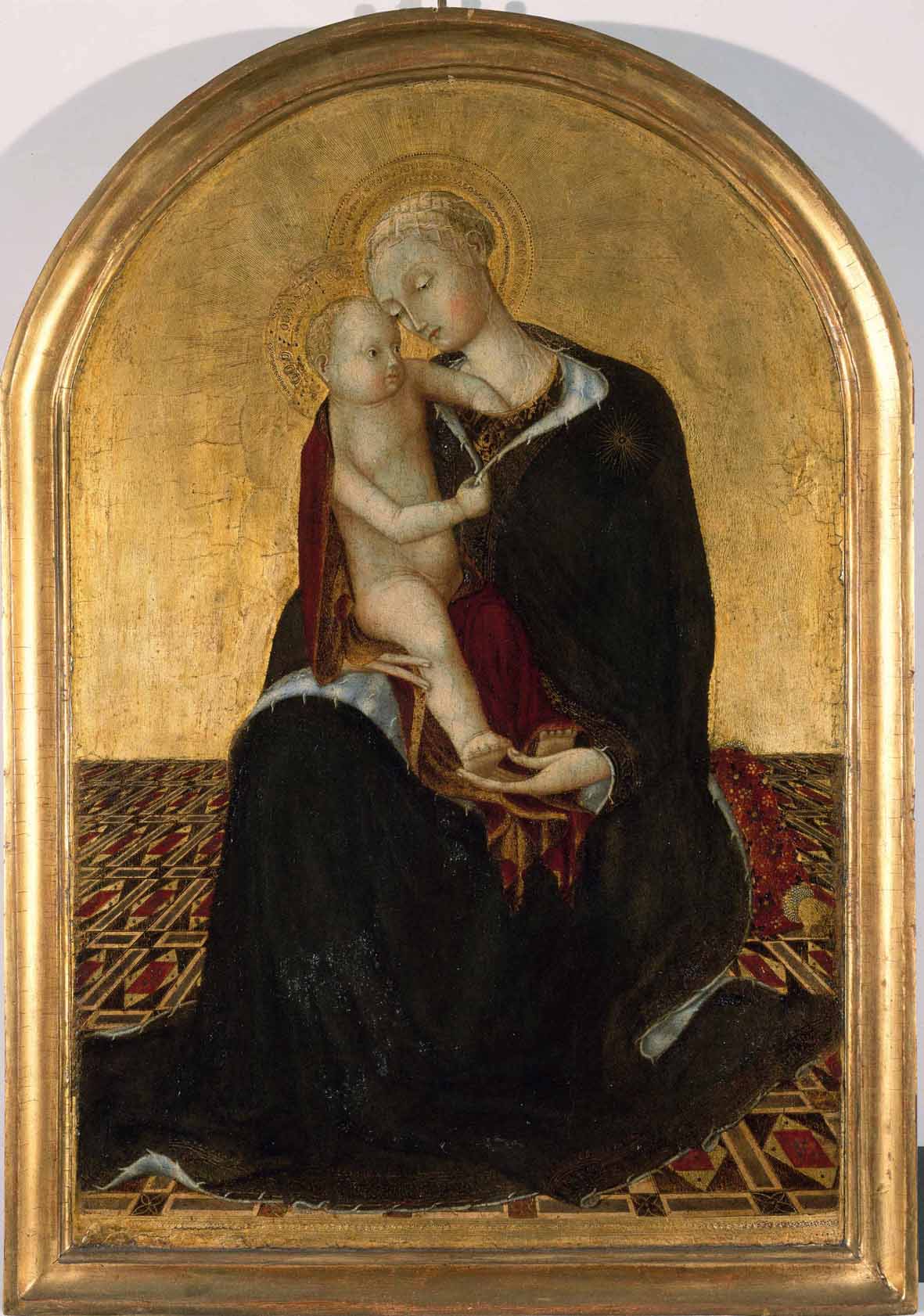 |
| Pietro di Giovanni Ambrosi, Madonna and Child (1446-1447; tempera on ribbed panel; Mamiano di Traversetolo, Magnani Rocca Foundation) |
Although the curator of the exhibition, Stefano Roffi, tells us that “more than the reference to precise works, the characteristics shared by the Sienese female figures of that time are valid for Modigliani; fingers, neck, eyes, elongated, tapered features, great elegance. This is a somewhat ’constitutional’ influence acquired from childhood, when, thanks to his cultured mother, Amedeo had the opportunity to visit churches and picture galleries in his native Tuscany (and beyond) and was fascinated by Madonnas. Later he would hang reproductions of these works on the walls of his ateliers; Tuscan linearism settled into his art until it re-emerged in the mature style of his painting.”
Illuminating in this regard are the words of Lamberto Vitali, taken from Drawings by Modigliani, 1929: “It is to him that the key to Modigliani’s art, the raison d’être of the deformations to which he subjects his models (from the elongated faces, tilted on the cylindrical necks that support the heads almost column-like), the sense of spiritual levity that emanates from his works, enjoyment that I cannot compare except to that of the harmonious figurations of a slow dance, have only one name: arabesque. That is why it seems to me that Modigliani [...] is from the same family from which came the Japanese and two Italians who expressed themselves in the same pictorial language: I mean Simone Martini and Sandro Botticelli. But above all to the Sienese I like to approach Modigliani: to Simone Martini, when he abandons narrative, to become a decorative painter (decorative, in the Berensonian sense)... a painter’s drawing is like the intimate diary of a man of letters; in it the artist reveals himself to you frankly, in his essential characters, without pretenses or tricks, which, moreover, the aristocratic contrast of black and white would ill tolerate... Rarely are chiaroscuro preoccupations found there; very often it is an equal and subtle sign, winding lightly spun, with singular purity, enclosing the forms in a well-rhythmic play of arabesques of exquisite elegance. The curves gradually intertwine and combine with an almost musical sense, between pauses and takes, intersections and suspensions, suggesting rather than describing, synthesizing rather than analyzing. And just as the motif of a pastoral flute evokes with its modulated cadences a whole ideal nostalgic world, so Modigliani’s arabesque surpasses the minute reality of the model, raising it to a different and superior world, where women nourished by a strange languor have bodies of virginal purity.”
Itall revolves around the loan of the Femme au col blanc that is the focus of the exhibition curated by Roffi, because from there not only does the interplay of influences unravel, justifying the presence of the other works and drawings, but also the doubts about such a seemingly cursory exhibition, which was in danger of passing into second place or of not being fully understood, are dispelled. What emerges is thus a valuable condensation of Modigliani’s artistic thought, as the outcome of a process internalized over time through the artist’s move from Italy (Livorno, Florence, Venice, etc.) to France, to Paris, in 1906.
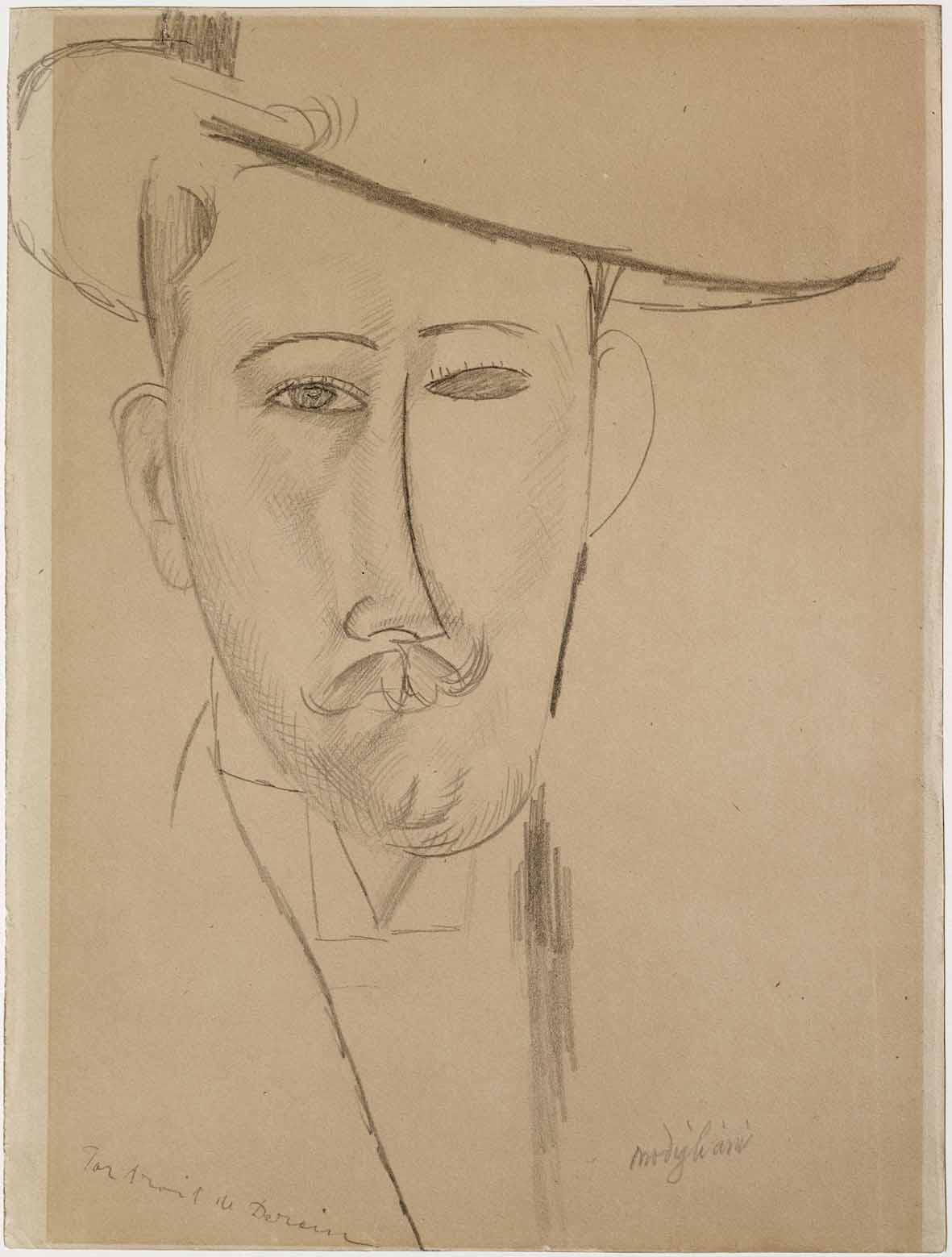 |
| Amedeo Modigliani, Portrait dhomme (ca. 1915; pencil on paper; Grenoble, Musée de Grenoble) |
 |
| Amedeo Modigliani, Portrait de Gillet (c. 1917-1919; pencil on paper; Grenoble, Musée de Grenoble) |
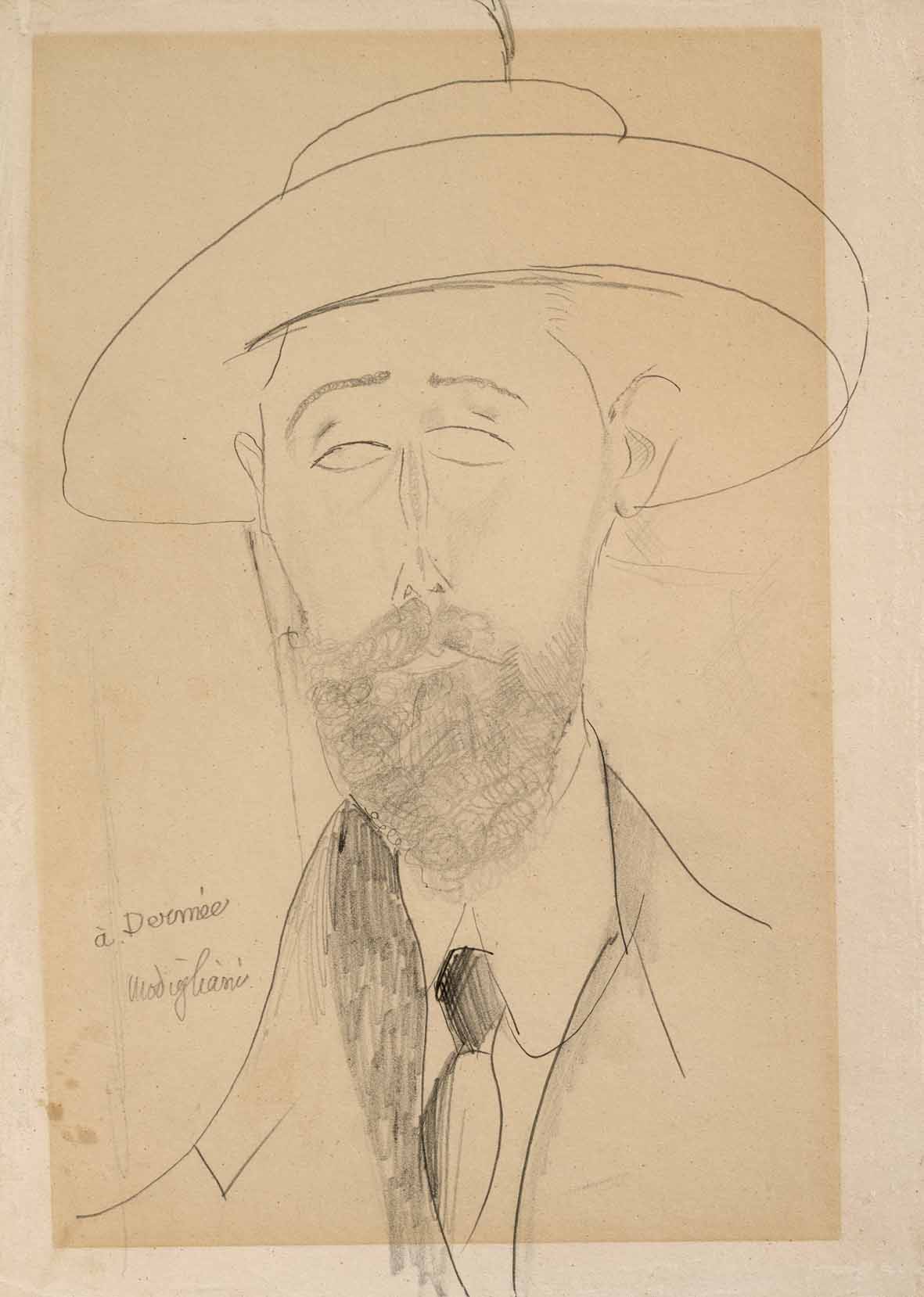 |
| Amedeo Modigliani, Portrait de Paul Dermée (ca. 1918-1920; pencil on paper; Grenoble, Musée de Grenoble) |
 |
| Paul Cézanne, Arbres (1887-1890; watercolor on paper; Mamiano di Traversetolo, Magnani Rocca Foundation) |
Paris was a city that Modigliani would live in with great enthusiasm, and in fact he would assiduously go to the Bateau-Lavoir, the famous artist’s residence (frequented by André Salmon, Guillaume Apollinaire, Max Jacob, and even Pablo Picasso, who despised Modigliani because of his Jewish origins), to the Montmartre district, he would also frequent the café Lapin Agile, a point of contact for many artists and intellectuals, which is where he met Suzanne Valadon and her son Maurice Utrillo (his great friend, along with Chaïm Soutine), and he would finally be a guest, through Doucet’s intermediary, at the house-atelier in rue Delta, where he would make the precious acquaintance of Paul Alexandre, a patron thanks to whom he would change his destiny as an artist forever.
The Ville Lumiè;re, in the early twentieth century, is above all the cradle of the great Universal Expositions, where precisely, it will be possible to see, study and finally appreciate other arts of the world that elaborated a different aesthetic concept, for the “Parisians” and for Modigliani resonated within, in particular, art from distant lands, such as the tribal art of the Ivory Coast. The enigmatic Gu language, a symbol of feminine beauty, the ancient exotic lure had been his Africa on French soil since 1915.
The prejudice of the cursed artist, Modi-maudit, motivated by the excessive use of alcohol and drugs and the impetuousness of his way of painting and sculpting, and which has always surrounded this artist, does not always find reason to exist. And this fact of truth also reverberates in the expertise and meticulous acuity with which he labors in the drawings he often gave away without signing. The six ’strands of lines’ in the exhibition superbly demonstrate this. Especially Dérain’s for its soft contours and use of Vélin paper.
Warning: the translation into English of the original Italian article was created using automatic tools. We undertake to review all articles, but we do not guarantee the total absence of inaccuracies in the translation due to the program. You can find the original by clicking on the ITA button. If you find any mistake,please contact us.